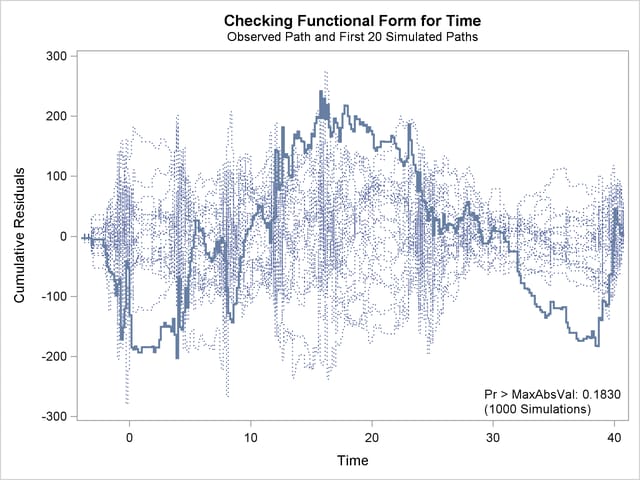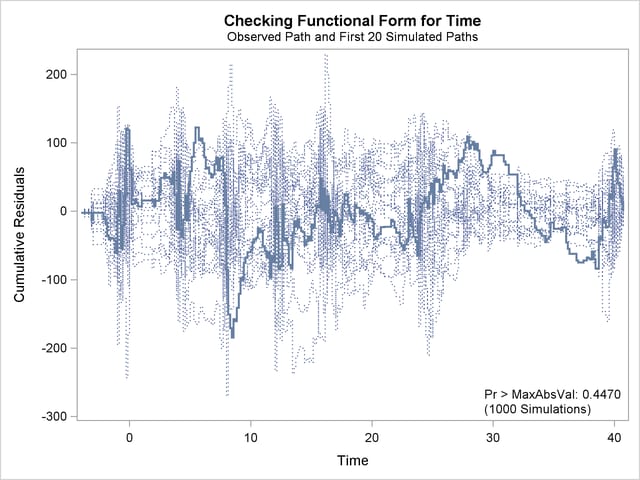| The GENMOD Procedure |
Example 37.9 Assessment of a Marginal Model for Dependent Data
This example illustrates the use of cumulative residuals to assess the adequacy of a marginal model for dependent data fit by generalized estimating equations (GEEs). The assessment methods are applied to CD4 count data from an AIDS clinical trial reported by Fischl, Richman, and Hansen (1990) and reanalyzed by Lin, Wei, and Ying (2002). The study randomly assigned 360 HIV patients to the drug AZT and 351 patients to placebo. CD4 counts were measured repeatedly over the course of the study. The data used here are the 4328 measurements taken in the first 40 weeks of the study.
The analysis focuses on the time trend of the response. The first model considered is
 |
where  is the time (in weeks) of the
is the time (in weeks) of the  th measurement on the
th measurement on the  th patient,
th patient,  is the CD4 count at
is the CD4 count at  for the
for the  th patient, and
th patient, and  is the indicator of AZT for the
is the indicator of AZT for the  th patient. Normal errors and an independent working correlation are assumed.
th patient. Normal errors and an independent working correlation are assumed.
The following statements create the SAS data set cd4:
data cd4; input Id Y Time Time2 TrtTime TrtTime2; Time3 = Time2 * Time; TrtTime3 = TrtTime2 * Time; datalines; 1 264.00024 -0.28571 0.08163 -0.28571 0.08163 1 175.00070 4.14286 17.16327 4.14286 17.16327 1 306.00150 8.14286 66.30612 8.14286 66.30612 1 331.99835 12.14286 147.44898 12.14286 147.44898 1 309.99929 16.14286 260.59184 16.14286 260.59184 1 185.00077 28.71429 824.51020 28.71429 824.51020 1 175.00070 40.14286 1611.44898 40.14286 1611.44898 ... more lines ... 711 488.00224 12.14286 147.44898 12.14286 147.44898 711 240.00026 18.14286 329.16327 18.14286 329.16327 ; run;
The following SAS statements fit the preceding model, create the cumulative residual plot in Output 37.9.1, and compute a  -value for the model.
-value for the model.
These graphical displays are requested by specifying the ODS GRAPHICS statement and the ASSESS statement. For general information about ODS Graphics, see Chapter 21, Statistical Graphics Using ODS. For specific information about the graphics available in the GENMOD procedure, see the section ODS Graphics.
Here, the SAS data set variables Time, Time2, TrtTime, and TrtTime2 correspond to  ,
,  ,
,  , and
, and  , respectively. The variable Id identifies individual patients.
, respectively. The variable Id identifies individual patients.
ods graphics on;
proc genmod data=cd4;
class Id;
model Y = Time Time2 TrtTime TrtTime2;
repeated sub=Id;
assess var=(Time) / resample
seed=603708000;
run;
ods graphics off;

The cumulative residual plot in Output 37.9.1 displays cumulative residuals versus time for the model and 20 simulated realizations. The associated  -value, also shown in Output 37.9.1, is 0.18. These results indicate that a more satisfactory model might be possible. The observed cumulative residual pattern most resembles plot (c) in Output 37.8.6, suggesting cubic time trends.
-value, also shown in Output 37.9.1, is 0.18. These results indicate that a more satisfactory model might be possible. The observed cumulative residual pattern most resembles plot (c) in Output 37.8.6, suggesting cubic time trends.
The following SAS statements fit the model, create the plot in Output 37.9.2, and compute a  -value for a model with the additional terms
-value for a model with the additional terms  and
and  :
:
ods graphics on;
proc genmod data=cd4;
class Id;
model Y = Time Time2 Time3 TrtTime TrtTime2 TrtTime3;
repeated sub=Id;
assess var=(Time) / resample
seed=603708000;
run;
ods graphics off;

The observed cumulative residual pattern appears more typical of the simulated realizations, and the  -value is 0.45, indicating that the model with cubic time trends is more appropriate.
-value is 0.45, indicating that the model with cubic time trends is more appropriate.
Copyright © SAS Institute, Inc. All Rights Reserved.